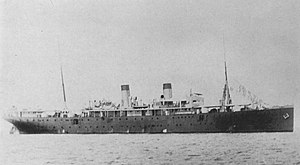
Back Корморан (кораб, 1909) Bulgarian Cormoran (Schiff, 1909) German اساماس کرموران (۱۹۰۹) Persian SMS Cormoran (1909) French SMS Cormoran (1909) Hungarian SMS Cormoran (1909) Italian Корморан (вспомогательный крейсер, 1909) Russian
 SMS Cormoran
| |
| History | |
|---|---|
| Name | Ryazan |
| Namesake | Ryazan |
| Builder | Schichau Yard at Elbing |
| Launched | 1909 |
| Out of service | 4 August 1914 |
| Fate | Captured by SMS Emden |
| History | |
| Name | SMS Cormoran aka SMS Cormoran II |
| Namesake | SMS Cormoran I |
| Acquired | 4 August 1914 |
| Commissioned | 10 August 1914 as SMS Cormoran II |
| Fate | Scuttled at Apra Harbor, Guam on 7 April 1917 |
| General characteristics | |
| Displacement | 3,500 t (3,400 long tons) |
| Speed | 17 kn (31 km/h; 20 mph) |
| Armament | 8 ×10.5 cm (4.1 in) SK L/35 quick-firing guns |
SMS Cormoran | |
| Location | Apra Harbor |
| Nearest city | Piti, Guam[2] |
| Coordinates | 13°27′33″N 144°39′15″E / 13.45917°N 144.65417°E |
| Area | 0.1 acres (0.040 ha) |
| Built | 1909[2] |
| NRHP reference No. | 75002156[1] |
| Added to NRHP | April 4, 1975 |
| Wreck of SMS Cormoran | |
|---|---|
 National Park Service illustration of the position of the Cormoran and Tokai Maru wrecks. The drive shaft of Cormoran lies closest to the bottom of the Tokai | |
| Dive type | Open-water, Deep, Wreck |
| Depth range | 80 to 120 ft (24 to 37 m) |
| Average visibility | 25 to 40 ft (7.6 to 12.2 m) |
| Entry type | Boat, very rarely shore |
| Bottom composition | Metal, silt |
| Nearby sites | Tokai Maru |
SMS Cormoran or SMS Cormoran II was a German armed merchant raider that was originally a German-built Russian merchant vessel named Ryazan. The ship was active in the Pacific Ocean during World War I. Built in 1909, she was captured by the German light cruiser SMS Emden on 4 August 1914 and converted into a raider at the German colony Kiautschou. She was forced to seek port at Apra Harbor on the US territory of Guam on 10 December 1914. The United States, then declared neutral in the war, refused to supply provisions sufficient for Cormoran to make a German port. After the US declaration of war on April 6, 1917, the Naval Governor of Guam informed Cormoran that she would be seized as a hostile combatant, prompting her crew to scuttle her.
© MMXXIII Rich X Search. We shall prevail. All rights reserved. Rich X Search
